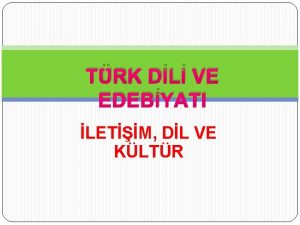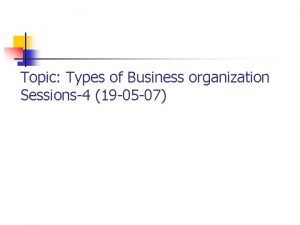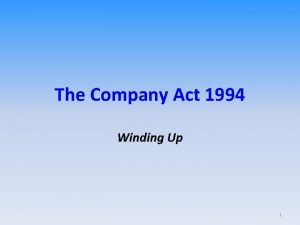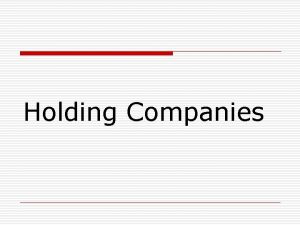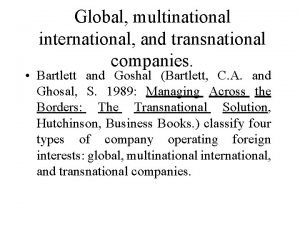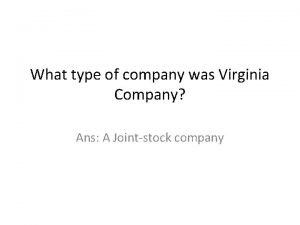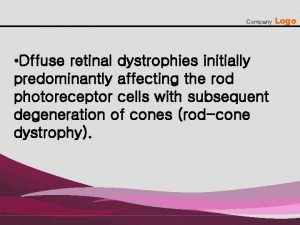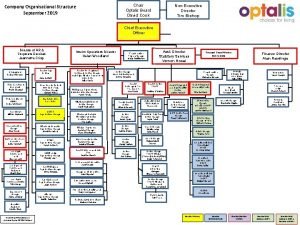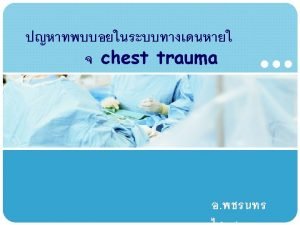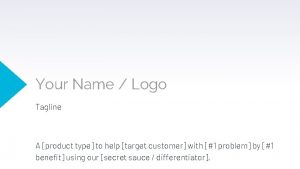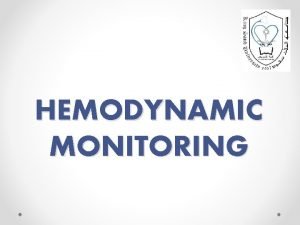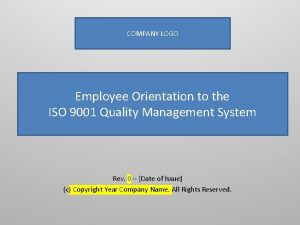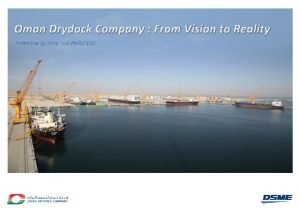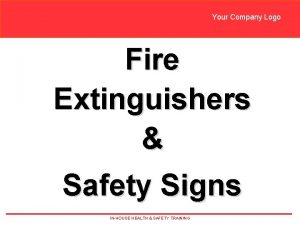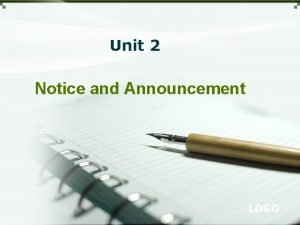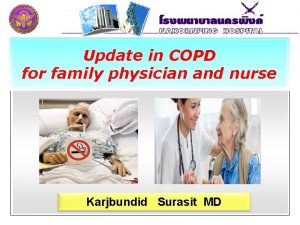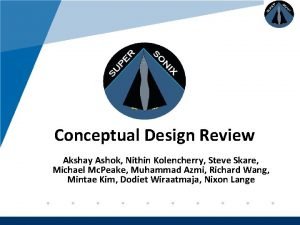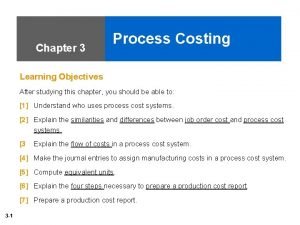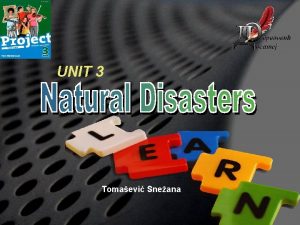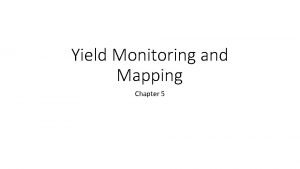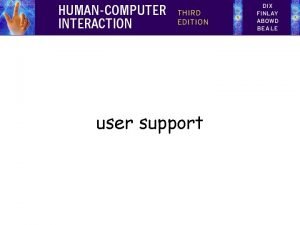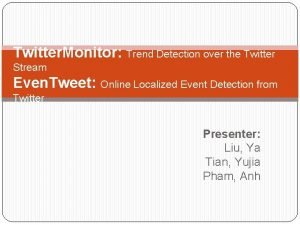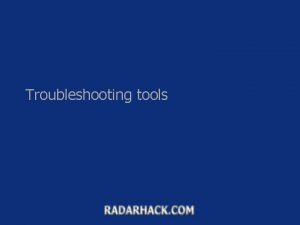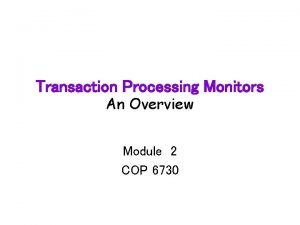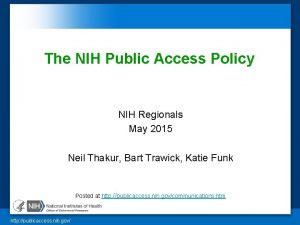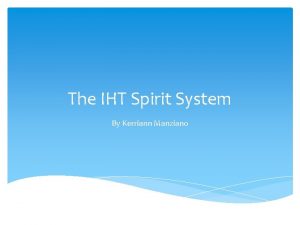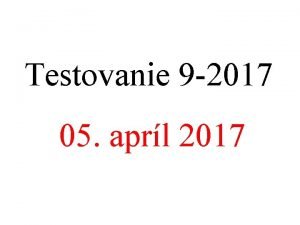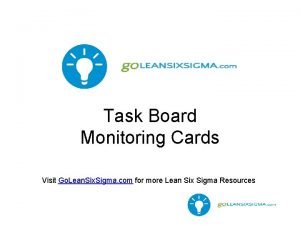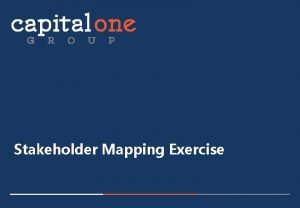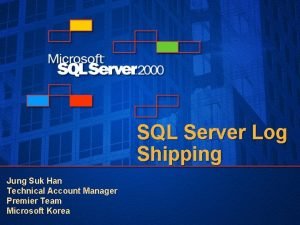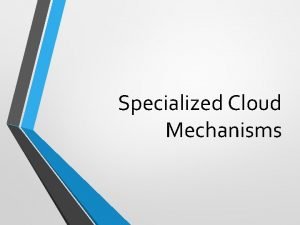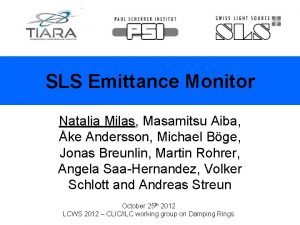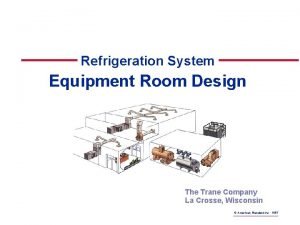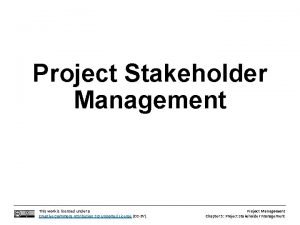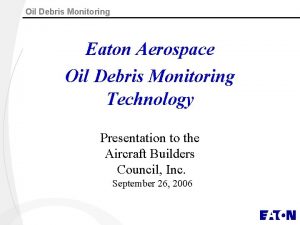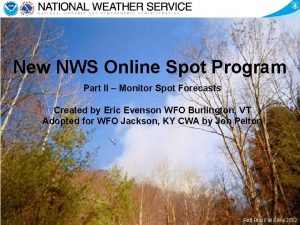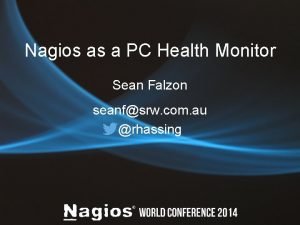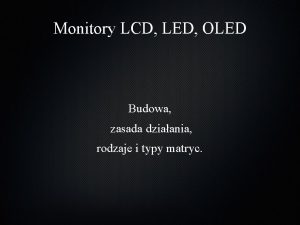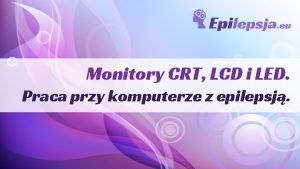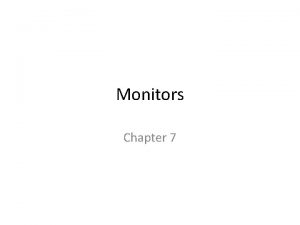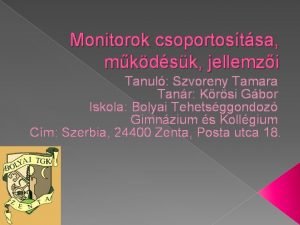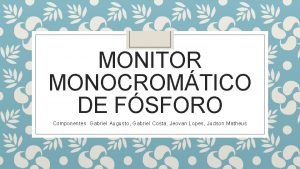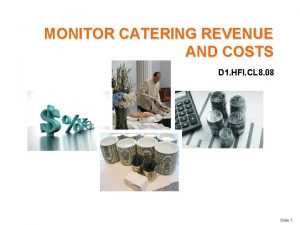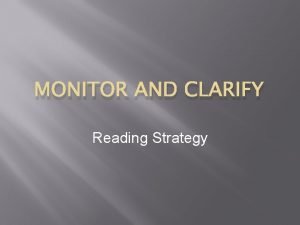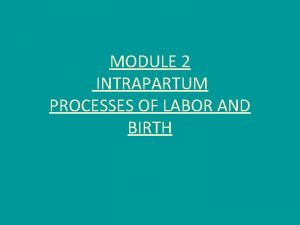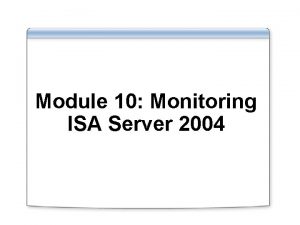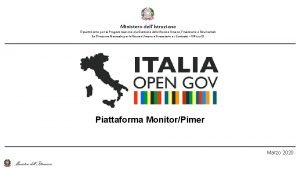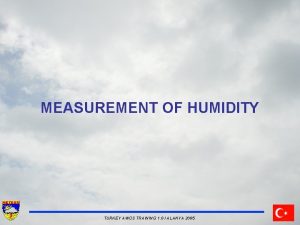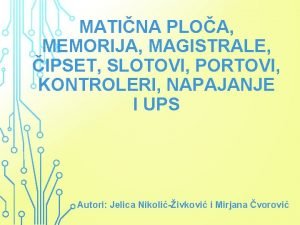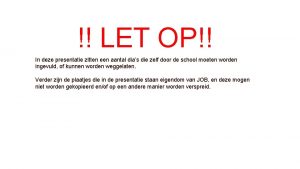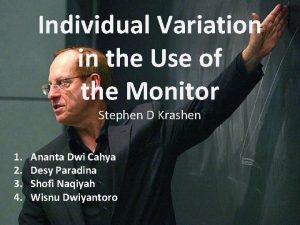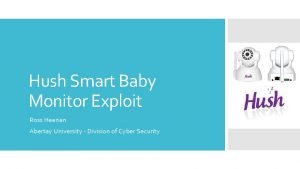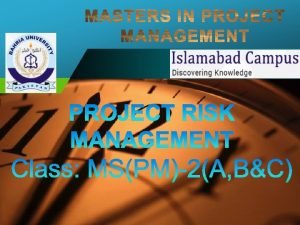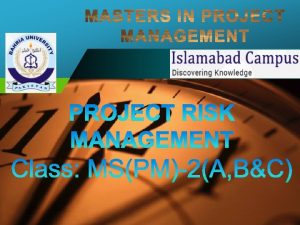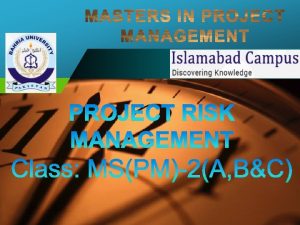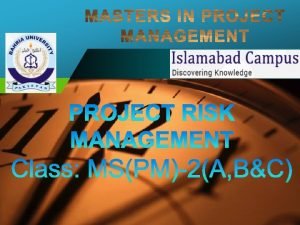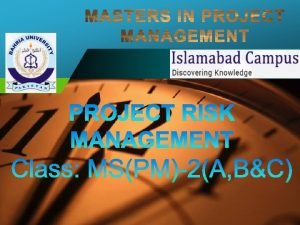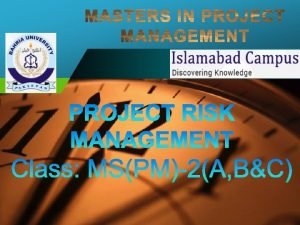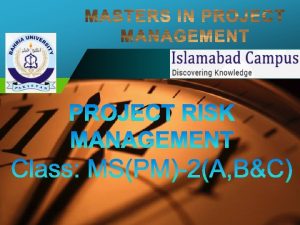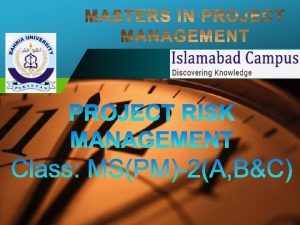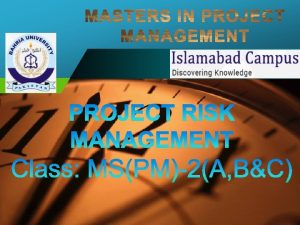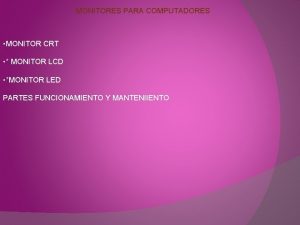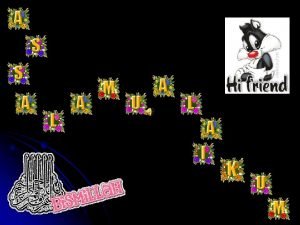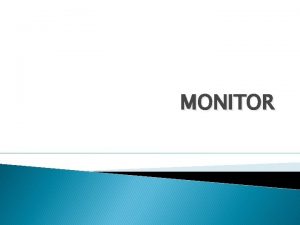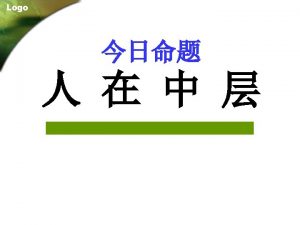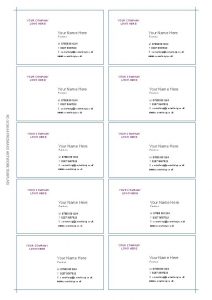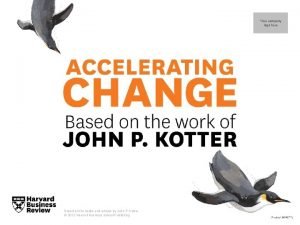Company LOGO Company LOGO oner Unit 10 Monitor































































- Slides: 63

Company LOGO

Company LOGO oner.

Unit 10. Monitor and Control Risks Content Purpose and Objective of the Monitor and Control Risks Process Critical Success Factors for the Monitor and Control Risks Process Tools & Techniques for the Monitor and Control Risks Process Documenting the Results of the Monitor and Control Risks Process Learning Objectives Understand how to Monitor and Control the planned responses and keep an eye on any new risks.

UNIT 11 MONITOR AND CONTROL RISKS

UNIT 11 Understand how to Monitor and Control the planned responses and keep an eye on any new risks.

UNIT 11 Purpose and Objective of the Monitor and Control Risks Process Critical Success Factors for the Monitor and Control Risks Process Tools & Techniques for the Monitor and Control Risks Process Documenting the Results of the Monitor and Control Risks Process

UNIT 11

UNIT 11 • The effectiveness of Project Risk management depends upon the way the approved plans are carried out. • These plans should be executed correctly, reviewed, and updated regularly. • If this is carried out correctly, the invested effort will be rewarded and future projects will benefit from this project’s experience. From Practice Standard for Project Risk Management, 1 st Ed, PMI

UNIT 11 • The primary objectives of risk monitoring and controlling are to • track identified risks, • monitor residual risks, • identify new risks, • ensure that risk response plans are executed at the appropriate time, and • evaluate their effectiveness throughout the project life cycle. • In addition to tracking and managing the risk responses, the effectiveness of all of the Project Risk Management processes should be reviewed to provide improvements to the management of the current project as well as future ones. From Practice Standard for Project Risk Management, 1 st Ed, PMI

UNIT 11 • For each risk or set of risks for which a contingent response has been defined, the corresponding set of trigger conditions should have been specified. • It is the responsibility of the action owner to ensure that these conditions are effectively monitored and that the corresponding actions are carried out as defined, in a timely manner. From Practice Standard for Project Risk Management, 1 st Ed, PMI

UNIT 11 • Once the Plan Risk responses process is complete, all of the approved unconditional response actions should have been included and defined in the current project management plan. • The first action of risk monitoring and controlling is to check whether this is the case and take any appropriate action if necessary, such as invoking the change management process with respect to any missing actions. • This will ensure that the agreed-upon actions are carried out within the normal project execution framework. From Practice Standard for Project Risk Management, 1 Ed, PMI st

UNIT 11 • The risk owners and the risk action owners need to be briefed on any changes that may affect their responsibilities. • Effective communication needs to be maintained between them and the project manager so that • the designated stakeholders accept accountability for controlling the potential outcomes of specific risks, • apply their best efforts to track the associated trigger conditions and • carry out the agreed-upon responses in a timely manner. From Practice Standard for Project Risk Management, 1 Ed, PMI st

UNIT 11 • In addition to the response actions and trigger conditions, a mechanism for measuring the effectiveness of the response is provided by the Plan Risk Responses process. • The risk action owner should keep the risk owner aware of the status of the response actions so that the risk owner can decide • when the risk has been effectively dealt with, or • whether additional actions need to be planned and implemented. From Practice Standard for Project Risk Management, 1 st Ed, PMI

UNIT 11 • As the project progresses, additional information becomes available and the management environment may change as some risks occur, whether foreseen or unforeseen, and others become or cease to be relevant. • The planning should therefore be kept current and the project manager should ensure that periodic risk reassessment, including risk identification, analysis, and risk response planning, is repeated at reasonable intervals, or in response to project events – without generating excessive administrative overhead. From Practice Standard for Project Risk Management, 1 st Ed, PMI

UNIT 11 Typical reasons for risk reassessment are: • Occurrence of a major or unexpected risk, • Need to analyze a complex change request, • Phase-end review, • Project re-planning or major plan elaboration, and • Periodic review to ensure that the information remains current. From Practice Standard for Project Risk Management, 1 st Ed, PMI

UNIT 11 • In the event of major organizational changes, risk management planning may need to be revisited prior to reassessing the risks. • In addition to the regular status reviews, periodic audits should be performed to determine strengths and weaknesses in handling risks within the project. • This should entail identifying any barriers to effectiveness or keys to success in risk management, recognition of which could lead to improvements in risk management of the current or future projects. From Practice Standard for Project Risk Management, 1 st Ed, PMI

UNIT 11 • At the end of the project, an integrated analysis of the risk management process should be carried out with a focus on long-term process improvements. • This analysis consolidates the findings of the periodic audits to identify lessons that would be applicable in general to a large proportion of the organization’s projects in the future, such as • appropriate levels of resources, • adequate time for the analysis, • use of tools, • level of detail, etc. From Practice Standard for Project Risk Management, 1 st Ed, PMI

UNIT 11 At project closure, the project manager should ensure that a description has been given of the closure of every risk register: a) did not occur b) occurred and contingency plan invoked c) occurred and impact to the project scope (i. e. , time, cost and quality). From Practice Standard for Project Risk Management, 1 st Ed, PMI

UNIT 11 • The output of the audit of the risk management process should be consolidated with specific information with respect to the project’s experience of risks, and any generally applicable guidelines for the organization should be highlighted and potential actions proposed for applying them. • This can lead to an update to the corresponding organizational process assets. From Practice Standard for Project Risk Management, 1 st Ed, PMI

UNIT 11 • An overview of the steps involved in the Monitor and Control Risks process is as follows: - From Practice Standard for Project Risk Management, 1 st Ed, PMI


8 4 Risk Monitoring & Control Process 11. 6 1 PROCESS OF IMPLEMENTING RISK RESPONSE PLANS, TRACKING IDENTIFIED RISKS, MONITORING RESIDUAL RISKS, IDENTIFYING NEW RISKS, EVALUATING RISK PROCESS EFFECTIVENESS THROUGHOUT THE PROJECT. 2 Tools and Techniques 3 11. 6 Inputs • Risk Register • Risk Management Plan • Work Performance Information • Performance Reports ______ _ Outputs • Risk Register Reassessme Updates nt • Organization • Risk Audits al Process • Variance and Assets Trend Updates Analysis • Change • Technical Requests Performance • Project Measurement Management • Reserve Plan Updates Analysis Reference: Figure 11. 19. • Project • Status PMBOK® Guide, 4 th Ed

Reference: Figure 11. 20. PMBOK® Guide, 5 th Ed

Reference: Figure 11. 19. PMBOK® Guide, 4 th Ed




UNIT 11

UNIT 11 9. 2. 1 Integrating Risk Monitoring and Control with Project Monitoring and Control 9. 2. 2 Continuously Monitor Risk Trigger Conditions 9. 2. 3 Maintain Risk Awareness From Practice Standard for Project Risk Management, 1 st Ed, PMI

UNIT 11 • From the start, the project management plan should include the actions required to monitor and control project risk. • This should be set up early in the project planning cycle, and then adjusted in view of the risk response planning decisions adding, for example, the actions associated with monitoring specific conditions or metrics. • Once risk response planning has been carried out, the project schedule should include all of the agreed-upon, response-related actions so that they can be carried out as a normal part of project execution and tracked accordingly. From Practice Standard for Project Risk Management, 1 st Ed, PMI

UNIT 11 • Risk response planning will have defined • a set of actions to be carried out as part of the project schedule as well as • actions whose execution is dependent on a predefined trigger condition. • Checking for specifically defined risks that may trigger conditional responses is the responsibility of the risk action owner, in close collaboration with the risk owner under the overall authority of the project manager. From Practice Standard for Project Risk Management, 1 st Ed, PMI

UNIT 11 • Risk management reports should be a register item on every status meeting agenda to ensure that • all team members remain aware of the importance of risk management and • to ensure that is fully integrated into all of the project management decisions. • The project’s senior-level sponsor should require regular reports on the risks and the planned responses to ensure that stakeholders are aware of the importance of keeping a focus on risk. From Practice Standard for Project Risk Management, 1 st Ed, PMI

UNIT 11 • Sponsor feedback also motivates the project team by demonstrating senior level interest in Project Risk Management. • Stakeholders perception of the effectiveness of risk management is conditioned in part by the way in which risks are handled as they occur, and by the number of characteristics of such events. From Practice Standard for Project Risk Management, 1 st Ed, PMI

UNIT 11 • It is therefore crucial, whenever a risk occurs, that information about the event, as well as the progress and effectiveness of the responses, be communicated at regular intervals and in an honest manner adapted to the needs of each stakeholder. • This should be supported by a well-executed communications plan. From Practice Standard for Project Risk Management, 1 st Ed, PMI

UNIT 11

UNIT 11 In addition to standard project management monitoring and control capabilities, risk monitoring and controlling requires a focus on the tools which will support its key success factors for tracking overall risk as well as individual risks. 9. 3. 1 9. 3. 2 9. 3. 3 9. 3. 4 Managing Contingency Reserves Tracking Trigger Conditions Tracking Overall Risk Tracking Compliance From Practice Standard for Project Risk Management, 1 st Ed, PMI

UNIT 11 • Reserves may have been allocated separately to cover timerelated and cost-related risks. • Techniques are required that allow the project manager to assess at any point in the project whether these provide the required level of confidence in the success of the project. • Tools for managing time buffers should be closely integrated into the project’s scheduling techniques. • Whereas those for managing cost should be compatible with the financial practices. • Tools are required to identify trends and forecast future outcomes to determine whether the reserves will remain sufficient. • Tools are also required for tracking progress and spending in a consolidated manner. From Practice Standard for Project Risk Management, 1 st Ed, PMI

UNIT 11 • Trigger conditions and the corresponding metrics are defined during the Plan Risk responses process. • Tools are required to evaluate and track these conditions against the project baseline or specified thresholds, based on actual status. • They can be chosen to provide information on risks related to the deliverables, such as performance, as well as on project-related features, such as time and cost. From Practice Standard for Project Risk Management, 1 st Ed, PMI

UNIT 11 • Tools are required in order to determine, as the project progresses, whether the responses are having the expected effect on the project’s overall level of risk. • In order to monitor the quality of the execution of the riskrelated plans and processes, a set of quality metrics such as degree of variation from the baseline, should be tracked and recorded. • These metrics will normally have been defined in the risk management plan. From Practice Standard for Project Risk Management, 1 st Ed, PMI

UNIT 11 Techniques for Monitor and control Risk are given in Table D below: - From Practice Standard for Project Risk Management, 1 st Ed, PMI

UNIT 11 From Practice Standard for Project Risk Management, 1 st Ed, PMI

UNIT 11 From Practice Standard for Project Risk Management, 1 st Ed, PMI

UNIT 11 From Practice Standard for Project Risk Management, 1 st Ed, PMI

UNIT 11

UNIT 11

UNIT 11 From Practice Standard for Project Risk Management, 1 st Ed, PMI

UNIT 11 From Practice Standard for Project Risk Management, 1 st Ed, PMI

UNIT 11 From Practice Standard for Project Risk Management, 1 st Ed, PMI

UNIT 11

UNIT 11 • The final control action of risk monitoring and controlling is to record actual data for future use. • This includes all of the relevant information relating to risk management from start to finish of the project. • The definition of what this information must include, as well as the storage mechanism, should have been previously specified in the risk management plan. • The goal is to ensure that the significant risk management information is recorded to provide concrete data to the lessons learned process for inclusion in a lessons learned document, report, or other communication vehicle. From Practice Standard for Project Risk Management, 1 st Ed, PMI

UNIT 11 Typical information includes the following: • For each identified risk or type of risk, whether it occurred, and if so, when and how often. All relevant data should be recorded: impact, effectiveness of detection and of response, and any unplanned, additional actions that were carried out. • Effectiveness of avoidance or exploitation actions. • Effectiveness of transfer and sharing actions. • Unexpected or undocumented risks which occurred and data about them. • Effectiveness of risk mitigation and enhancement actions. • Occurrence of accepted threats or opportunities. From Practice Standard for Project Risk Management, 1 st Ed, PMI

UNIT 11 • Consolidated information should be provided on the level of effort expended. • Costs and benefits to the project of risk management activities should also be provided. • This information will need to be archived and indexed in a manner that will facilitate retrieval for easy review • during the project, • at closure, and • for future projects, when the need arises. From Practice Standard for Project Risk Management, 1 st Ed, PMI

UNIT 11

PMP Exam Prep, 5 th Ed, Rita Mulcahy, RMC Publications

UNIT 11

UNIT 11 • • • Prevent the root cause of change Identify change Create change request Assess the change Look at the impact of the change Perform integrated change control Look for options Change is approved or rejected Adjust the project management plan and baselines Notify stakeholders affected by the change Manage the project to the new project management plan PMP Exam Prep, 5 th Ed, Rita Mulcahy, RMC Publications

UNIT 11 PMP Exam Prep, 5 th Ed, Rita Mulcahy, RMC Publications

UNIT 11

UNIT 11

UNIT 11 The integrated change control process is listed in the monitoring and controlling process group, but it really occurs during all the project management processes. For example, various management plans are created in project planning, Integrated change control should be done during project planning to approve or reject requested changes to the planning portion of management plans. PMP Exam Prep, 5 th Ed, Rita Mulcahy, RMC Publications

UNIT 9

The End THE END THANK YOU

 Alıcıyı harekete geçirme işlevi
Alıcıyı harekete geçirme işlevi Unit 10, unit 10 review tests, unit 10 general test
Unit 10, unit 10 review tests, unit 10 general test Partnership vs limited company
Partnership vs limited company Winding up of a company
Winding up of a company Subsidiary company meaning
Subsidiary company meaning Difference between global company and multinational company
Difference between global company and multinational company What type of company was the virginia company?
What type of company was the virginia company? C logo
C logo Company logo
Company logo Lurvin munisami
Lurvin munisami Company
Company Company name logo tagline
Company name logo tagline Name the
Name the Swan ganz catheter
Swan ganz catheter Iso company logo
Iso company logo Company logo transfers
Company logo transfers Oman drydock company logo
Oman drydock company logo Company logo
Company logo Lost and found notice
Lost and found notice Lama laba sama saba
Lama laba sama saba Company logo
Company logo Company logo
Company logo Insert logo here
Insert logo here Abc company logo
Abc company logo Company structure unit 3
Company structure unit 3 Company structure unit 3
Company structure unit 3 Cost of production report
Cost of production report Unit 3 logo
Unit 3 logo Yield monitoring techniques
Yield monitoring techniques What is anesthesia
What is anesthesia Types of user support in hci
Types of user support in hci Saed sayad
Saed sayad Fwmonitor
Fwmonitor Transaction processing monitor
Transaction processing monitor Public access compliance monitor
Public access compliance monitor Https://ihtusa.com/
Https://ihtusa.com/ Testovanie 9 2017
Testovanie 9 2017 Monitor task cards
Monitor task cards Keep satisfied manage closely monitor keep informed
Keep satisfied manage closely monitor keep informed How to monitor log shipping in sql server 2005
How to monitor log shipping in sql server 2005 Sql 2005 activity monitor
Sql 2005 activity monitor Multi device broker in cloud computing
Multi device broker in cloud computing Sls monitor
Sls monitor Trane refrigerant monitor
Trane refrigerant monitor Threat matrix example
Threat matrix example Engine oil debris sensors
Engine oil debris sensors Spot weather monitor
Spot weather monitor Pc health monitor
Pc health monitor Matryca lcd budowa
Matryca lcd budowa Monitory crt
Monitory crt The main disadvantage of semaphore definition is
The main disadvantage of semaphore definition is Monitorok csoportosítása
Monitorok csoportosítása Monitor de fosforo
Monitor de fosforo Monitor catering revenue and costs
Monitor catering revenue and costs Clarifying reading strategy activities
Clarifying reading strategy activities What do braxton hicks look like on monitor
What do braxton hicks look like on monitor Isa server monitor
Isa server monitor Monitor-pimer
Monitor-pimer Bis monitor range
Bis monitor range Humidity sensor turkey
Humidity sensor turkey Magistrale na maticnoj ploci
Magistrale na maticnoj ploci Jobmbo.nlmonitor
Jobmbo.nlmonitor Individual variation in monitor use
Individual variation in monitor use Hush baby monitor
Hush baby monitor
